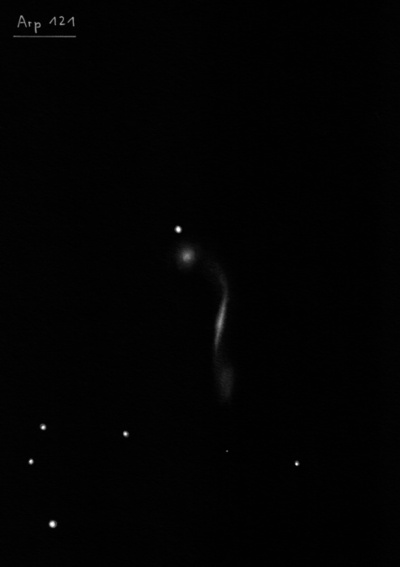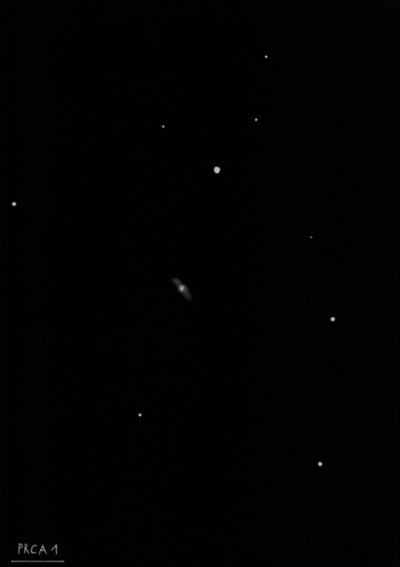A large constellation, the fourth largest, located mostly in the southern sky. Only the head of the Whale, the stellar pentagon, extends north of the world equator. The Whale extends south of Aries and Pisces and lies well away from the Milky Way. Although it essentially fills a large empty space in the sky, the star pattern that forms the constellation's skeleton is not hard to find in a dark sky. The head of the Whale, adjacent to Taurus, is formed by the stars Menkar (2.53mag), γ (3.47mag), ξ (4.28mag) and μ Ceti (4.27mag), followed by the constellation's main jewel, the long-period variable Mira Ceti, with the glow of Deneb Kaitos (2.04mag) on its tail. Missing from the deepsky objects are open clusters and diffuse nebulae. The main objects of interest are the Seyfert galaxy M77, the nice planetary nebula NGC 246, a fair number of nice binaries and, for large telescopes, a number of distant galaxies.
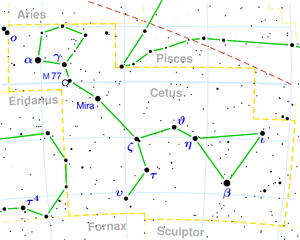
Deneb Kaitos (β Cet) - With a brightness of 2.04 mag, it is the brightest star in the constellation. However, when the long-period variable star Mira Ceti is at its maximum, it becomes the brightest in the constellation. The line connecting the stars Alpheratz and Gamma Pegasi from the Square of Pegasus points to Deneb Kaitos. It is occasionally confused with the star Fomalhaut, but it is one magnitude fainter than it. It is located 96 light-years away.
Menkar (α Cet) - The orange field of apparent brightness 2.53mag is located 250 light-years away from us. At a distance of nearly 16', the star 93 Ceti (5.6mag) lies to the north, visible to the naked eye as an optical companion.
Mira Ceti (ο Cet) - The most famous long-period variable star, about which the Dutch amateur observer David Fabricius in Germany believed on August 13, 1596 that it was a new star, similar to the recent Tycho's star from 1572. In the then or older atlas, no star of magnitude 3 was drawn in the neck of the Whale. Only during its observation over the next year did he realize that it changes its brightness. As the first one, even before the invention of the telescope during Galileo's time, he discovered the first variable star in the history of astronomy! The star gradually disappeared and reappeared, until in 1603 the German astrocartographer Johann Bayer included it in his atlas as an object of magnitude 4. Later, in 1662, Jan Hevelius named it "Mira stella" - the wonderful star. The tip of the letter "V" formed by the stars from the constellation of Pisces points to it. Mira is located 300 light-years away.
Kaffaljidhma (γ Cet) - A beautiful close physical binary star, distinguishable in a 100 mm telescope, with a yellow component of magnitude 3.5 and a white component of magnitude 7.3. It is separated by 2.8". The mutual orbital period of this pair is estimated to be several millennia. In a 200 mm telescope, a red dwarf of magnitude 10 is added, which is also part of the system. It is separated by 14'. The entire system is located approximately 80 light-years away.
τ Cet - Its slow rotation points to the possible existence of a planetary system and thus the possibility of the emergence and existence of life on this yellow dwarf star similar to the Sun (both in temperature and luminous power). It would be one of our closest planetary systems, located 11.85 light-years away from Earth. Therefore, it was selected for the Ozma project, whose goal is to establish contact with potential nearby civilizations through radio waves. Along with the star Epsilon Eridani, it was also chosen for the original research project of SETI (Search for Extra-Terrestrial Intelligence).
66 Cet - The star consists of two companions with magnitudes of 5.7 and 7.5. Their angular separation is 16.5 arcseconds. While in small telescopes they appear as a pair of yellow and blue components, in a 200 mm telescope the color of the second component changes to violet.
M 77
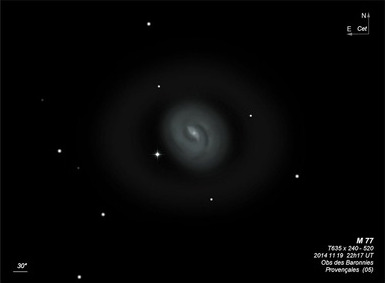
Pierre M?chain discovered M77 = NGC 1068 = h262 on 29 Oct 1780. William Herschel described M77 as "Very bright; an irregular extended nucleus with milky chevelure, 3 or 4' long, near 3' broad."
Lord Rosse's assistant Johnstone Stoney recorded M77 on 22 Dec 1848 as "a blue spiral?" and it was included in the list of "Spiral or curvilinear" object in Rosse's 1850 PT paper. Observing assistant Bindon Stoney made a sketch on 24 Nov 1851 (the description reads "The central part is, I am nearly sure, spiral") shown on plate XXV, figure 6 in LdR's 1861 paper (also Plate 1, Figure 4 in the 1880 publication). William Lassell's 1863 sketch, made using 760x with his 48-inch from Malta, shows a tight spiral emanating from a bright stellar nucleus and wrapping a full 360?.
Isaac Roberts' photograph in 1892 revealed considerable structure in the central region with a "dense composite nucleus, bounded by a broad nebulous ring, which is studded with strong condensations.."
200/250mm - 8" (11/28/81): bright, intense core, faint halo.
400/500mm - 17.5" (11/14/87): very bright, moderately large, sharp concentration with an unusually bright core, almost stellar nucleus, diffuse slightly elongated halo. Appears mottled at high power and a hint of inner arm structure. A mag 11 star is 1.3' ESE of the center. This is a Seyfert 2 galaxy and brightest in a group with NGC 1055 and 1073..
900/1200mm - 48" (10/26/11): at 375x; the view through Lowrey's 48-inch was remarkable. Spiral arm structure was easily visible with two main arms in the central halo and a bright inner arm around the nucleus and core. The bright inner arm attaches at the east side of the intense core, wraps tightly clockwise around the north side of the core and heads south on the west side of the core. There were two main arms in the central halo forming an elongated "S" pattern. A long spiral arm is attached near the east side of the core and wraps clockwise outside the inner arm described above. It continues around to the west side and heads south, ending near a compact HII knot ([EKS96] 19 from Evans et al 1996 "Atlas of H II Regions in Nearby Seyfert Galaxies"). A second long spiral arm is attached on the southwest side of the core and wraps clockwise to the east side of the core, passing inside of a 10" HII knot [EKS96] 79/80]. The arm rotates to the northern edge of the halo. Besides these main arms, several fainter sections of additional arms are tightly wrapped in the central halo. The main central region of the galaxy is encased in a very large, low surface brightness outer halo, extendng ~6'x5' WSW-ENE. NGC 1055, part of the M77 group, lies 30' NNE.
Notes by Steve Gottlieb
NGC 247
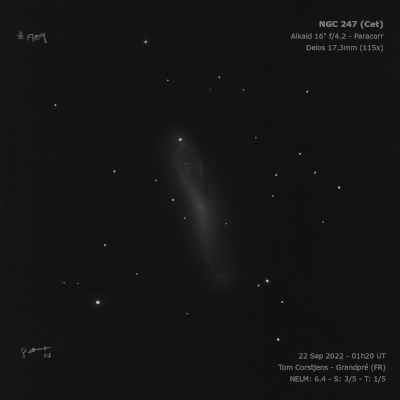
William Herschel discovered NGC 247 = H V-20 = h57 on 20 Oct 1784 (sweep 303) and logged "a Streak of light about 27' long, and in the brightest part, which was pB is 3' or 4' broad. The extension nearly in the meridian (I believe a little from from S.p. to N.f.) ... The situation is so low, that it would probably appear of much greater extent in a higher altitude." John Herschel observed NGC 247 at Slough on 16 Sep 1830 (sweep 293) and noted "eF; vL; vmE; vglbM; 10' long; pos 172.0 deg. Has no bright star in it, but a star 8.9 mag at some distance n.p." Surprisingly, he made no (published) observations at the Cape of Good Hope.
Based on a photograph taken with the Crossley reflector, Heber Curtis described NGC 247 as "a faint, very large spiral, 18'x5' in p.a. 175°. Nucleus stellar; many almost stellar condensations. Whorls somewhat irregular, and indistinct." (1918)
200/250mm - 8" (10/4/80): very large, elongated ~N-S, bright core. A mag 10 star is at the south tip. The southern extension appears brighter.
300/350mm - 13" (8/5/83): fairly bright, diffuse, very large, bright core.
400/500mm - 17.5" (11/1/86): bright, very large, bright core, elongated 7:2 N-S, 14'x4'. The southern extension is brighter and mag 9 SAO 166572 is superimposed at the southern end about 6' from the core. Burbidge's Chain (VV 518) lies 18' NNE.
900/1200mm - 48" (10/31/13): at 287x, NGC 247 spanned at least 18'x5' NNW-SSE and stretched from an HII region at the NNW tip to beyond a mag 9.5 star (HD 4529) near the SSE end. A very large, elongated darker region (though not primarily caused by dust extinction), dubbed the "Needle's Eye", forms an interesting feature on the NNW side of the halo. Visually it extended at least 3.5'x1.0'. A relatively bright HII knot (identified in NED as MRSS 540-038059 from the "Muenster Red Sky Survey") is beyond this feature at the NNW end of the major axis, 9.5' from center. This knot appeared fairly faint, relatively large for an HII region, elongated ~N-S, 20"x12". A second well-defined HII knot is MRSS 540-038506, found 5' NNW of center. This easy patch appeared fairly faint, elongated, 15"x10". At least two small knots (including MRSS 540-038001) are on the SW side of the halo, ~2.4' from center and ~1.5' E of a mag 12-12.5 star just off the west edge of the disc. Finally, I picked up a faint, very small knot, ~6" diameter, situated 3.5' SSE of center and 1.1' N of a mag 13.5 star. This HII region (not in the MRSS) forms a "double" with a mag 15 star 15" N.
Notes by Steve Gottlieb
NGC 246
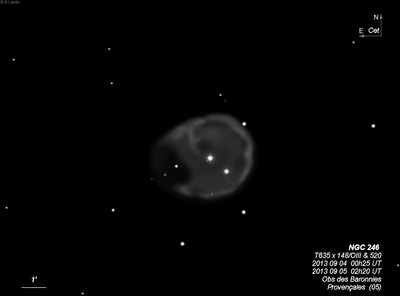
16x80 (8/24/84): faintly visible in finder.
80mm finder (10/13/07): visible unfiltered at 25x. Nice contrast gain using the NPB filter and the planetary also appears to increase in size.
William Herschel discovered NGC 246 = H V-25 = h56 on 27 Nov 1785 (sweep 478) and recorded "four or five pL stars forming a trapezium of 4 or 5' diameter. The enclosed space is filled up with milky nebulosity faintly terminated. The stars seem to have no connection with the nebulosity." The 1973 Revised New General Catalogue of Nonstellar Objects (RNGC) reversed the sign of the declination (+), and this typo was copied into some amateur software and digital setting circles.
Isaac Roberts described NGC 246 as a spiral nebula based on an early photograph. In 1912 Knox-Shaw reported it was not a spiral, but "like the Owl nebula", based on a photograph taken at the Helwan Observatory with the Reynolds reflector from 1909-11. Still Hardcastle later classified NGC 246 as a spiral nebula. Campbell (at Lick) and Paddock found the spectrum to be of a PN. Based on a Crossley photograph, Heber Curtis described (1918) "a somewhat irregular oval, brightest on western edge; 4'x3.5' in PA 120°. Periphery clear-cut, with a broken ring effect. Very faint, irregular matter in inner parts. The central star is bluish, and considerably brighter photographically than visually."
200/250mm - 8" (11/5/83): fairly faint, large, four stars involved. No annularity noted.
300/350mm - 13" (11/5/83): fairly bright with filter, clearly annular, sharper edges. NGC 255 lies 15' SSE.
400/500mm - 17.5" (1/8/00): at 100x, appears as a moderately bright, 3.5' irregular glow with a darker center and encompassing four stars including the 12th magnitude central star. Excellent contrast gain using an OIII filter, which sharpens up the edge of the roundish annulus and enhances the irregular surface brightness. The halo is brightest along a 270° arc running from SW to NE and is clearly weakest at the east edge of the halo. A mag 11.5 star is embedded at the NW edge of the halo 2.0' from center. The irregular central hole is much darker but faintly luminous. A mag 12 star is also superimposed southwest of the central star and a 4th star is just inside the eastern boundary. The central star forms a thin right triangle with the other two brighter stars. At 220x, the western 90° outer arc is brightest and there appears to be a knot embedded at the NE edge of the halo.
17.5" (9/19/87): fairly bright, large, 4' diameter, annular. Four stars are involved including the central star. This planetary has an irregular surface brightness with subtle structure.
600/800mm - 33" (9/16/07): gorgeous annular planetary viewed at 200x. The thin brighter rim was striking and varied in brightness and thickness around the periphery. The rim is brightest along the western or WNW edge and weakest on the east side. The interior was darker but irregular in surface brightness.
900/1200mm - 48" (10/23/14): At 488x with an NPB filter the view of the Skull Nebula was breathtaking and all the structure in a detailed photograph was visible. The thin brighter rim varied in brightness, thickness and scalloped structure along its entire length.
The rim is brightest along a 60° arc on the western side, bulging inward just north of center, creating a small darker indentation in the rim due west of the prominent central star. Moving counterclockwise around the rim, a small brighter, elongated patch is at the northwest edge, close to a mag 11.5 star just outside the planetary. The rim is relatively weak along the north side, but two brighter (detached) patches are along the northeast side. An irregular, elongated luminous patch spreads inward here. This glow is fairly prominent just northeast of center, on line with the central star and the second interior mag 12 star (southwest of center). A second luminous patch is midway from the central star to the north rim. The rim is weakest overall along a 90° arc on the eastern side, near a mag 13.5 star, which is embedded just within the planetary. Two more luminous patches are visible at the south rim, with the westernmost glow both larger and brighter.
The interior is relatively dark, though glows weakly with subtle variations, creating pockets of darkness - one is northeast of the central star - and mild enhancements. A small diaphanous glow is just south of the mag 12 star on the southwest side. More extensive milky nebulosity extends inward from the southern rim, though the most prominent interior glow is the split nebulosity mentioned earlier on the northwest side.
Notes by Steve Gottlieb
IC 1613
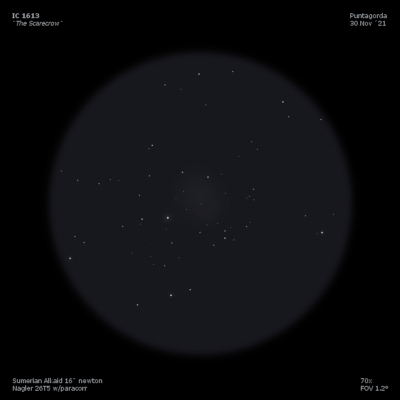
Max Wolf discovered IC 1613 on a plate taken with the Bruce 16-inch telescope in September 1906. Wolf's position (given in 1885 coordinates) is ~10' south and 1.5 minutes of time preceding the galaxy. As he used BD stars to measure positions, it's very possible the coordinates for the "densest part" are for 1855. If so, his position is near the center of IC 1613!
William Baade first showed it was extragalactic in 1935 and a year later Hubble included it as a Local Group member. The distance is ~2.4 million light years.
300/350mm - 13.1" (12/22/84): faint, large, extremely diffuse. This Local Group member appears as an irregular hazy region with a large brighter section to the NE and a fainter section to the SW. No visible core. Several brighter stars are in the field includes a star at the SW edge. Located 46' N of 26 Ceti.
400/500mm - 18" (9/15/07): faint, very large, irregular glow, roughly elongated 4:3 SW-NE, ~8'x6'. A mag 10.5 star is just at the west edge of the glow. A very small knot (HII region?) or core is faintly visible just 2' E or ENE of the mag 10.5 star. There appears to be a very faint detached piece to the northeast about 7' from the mag 10.5 star. Located ~12' S of mag 7.2 HD 6375.
900/1200mm - 48" (10/26/16): I spent a few minutes identifying OB associations in the patchy northeast section section of IC 1613. At 375x I was able to pinpoint a half-dozen faint or fairly faint "knots", generally 12"-15" in diameter within a 1.5' region. The identifications below are from Paul Hodge's 1978 study "The structure and content of IC 1613" and the Borissova et al. 2004 paper "The catalogue of OB associations in IC 1613".
[H78] 10 = [BKG04] G7, the brightest patch, is on the west edge and seen as moderately bright, small, 12" diameter. A star or stellar object is involved. Close northeast and southeast are [H78] 13 = [BKG2004] G11 and [H78] 14 = [BKG2004] G14, both easily seen as fairly faint glows, ~15" diameter. [H78] 17 = [BKG2004] G25 is very faint knot 1' E of [H78] 13 and [H78] 15 = [BKG2004] G15 was visible 30" S of [H78] 14. [H78] 11 = [BKG2004] G10 was also easily seen as a 12" knot 1.5' N of [H78] 10.
Notes by Steve Gottlieb
NGC 908
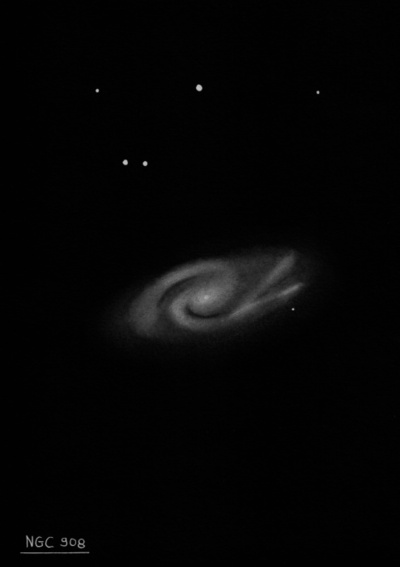
William Herschel discovered NGC 908 = H I-153 on 20 Sep 1786 (sweep 596) and noted "cB, vL, E from sp to nf, I believe above 15' long; but the ends are very faint." His position (CH's reduction) is accurate. John Herschel made no observations of this galaxy either from Slough or the Cape. The NGC position is accurate.
200/250mm - 8" fairly bright, large, elongated E-W.
400/500mm - 17.5" (12/4/93): fairly bright, large, elongated 4.5'x2.0' WSW-ENE. The brighter middle has an irregular surface brightness and a faint star or knot is just west of the geometric center [this is probably the nucleus]. A mag 14 star is just south of the following end. Four mag 11-12.5 stars lie 3' to 5' N and form a trapezoid with parallel bases oriented E-W.
900/1200mm - 48" (10/27/19): at 375x; Showpiece two-armed spiral extending 5'x2' WSW-ESE and displaying a great deal of structure. Contains a bright oval core with a very small, very bright nucleus. A knotty spiral arm is rooted at the northeast end of the core. It bends sharply to the west on the north side of the core and displays a blotchy surface. As this arm extended west it separated from an inner arm by a dark lane, spread out and faded at the west end.
A longer spiral arm emerges from the west side of the core. It wraps tightly to the east in a bright arc to the south of the core. This arm has a fairly well defined outer edge, but was not as splotchy as the northern arm. At the east end, it splits into two arms with a slightly darker gap between and passes north of a mag 14.4 star. The northern split arm has a brighter 15" patch at its tip [1.0' NNW of the mag 14.4 star].
Notes by Steve Gottlieb
NGC 936
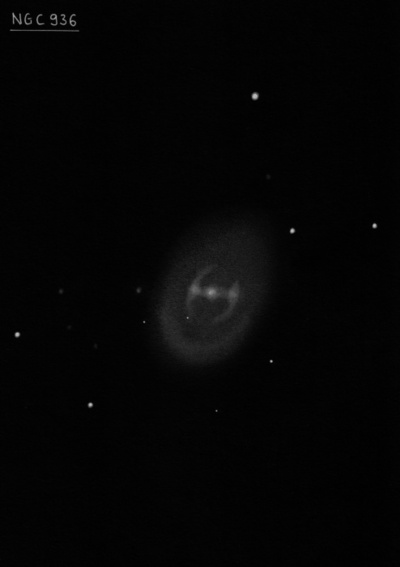
William Herschel discovered NGC 936 = H IV-23 = h223, along with NGC 941, on 6 Jan 1785 (sweep 351) and logged "cB, a very bright nucleus with a chevelure of 3 or 4' diameter." He placed this nebula in the fourth class, which included planetary nebulae as well as stars with burs, with milky chevelure, with short rays, remarkable shapes, etc. On 24 Nov 1827 (sweep 108), John Herschel logged it as "vB; vL; R; psmbM; 2' diame; fades away insensibly."
Based on photographs taken at the Helwan Observatory in Egypt, it was described in 1921 as "4'x3', E145°, vB almost stellar nucleus; a Phi-type spiral with pB cross-arms in p.a. 80° and 1.5' long, surrounded by a vF oval haze showing no structure.
200/250mm - 8" (1/1/84): bright, moderately large, very bright core, oval NW-SE. Forms a pair with NGC 941 12' E.
400/500mm - 17.5" (12/4/93): bright, fairly large, very bright core 30"x20" elongated E-W (bar), core increases to almost stellar nucleus. The much larger fainter halo extends up to 3.0'x1.5'. Three mag 9 stars lie N; mag 8.7 SAO 129912 8' NNW, mag 9 SAO 12911 12' NNW, mag 9.5 12' N. Forms a wide pair with NGC 941 12.5' E and UGC 1945 is 14' SE.
Notes by Steve Gottlieb
NGC 1052
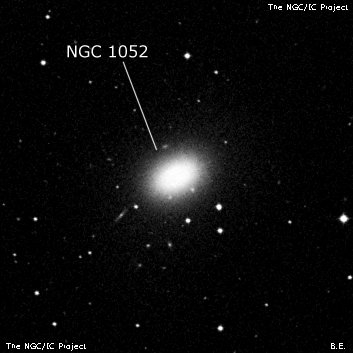
William Herschel discovered NGC 1052 = H I-63 = h254 = h2493 on 10 Jan 1785 (sweep 355) and recorded "B, R, mbM, about 1' diameter, vF towards the border." His position is matches PGC 10175. John Herschel observed this galaxy twice at Slough, recording on 8 Jan 1831 (sweep 318), "B; S; R; 20"; gb and psmbM to a *12".
200/250mm - 8" (11/8/80): faint, bright core.
300/350mm - 13.1" (9/9/83): bright, small, round, intense core. Brightest in a large group with three galaxies in 62x field including NGC 1042 14' SW and NGC 1047 10.2' NW.
13.1" (9/3/86): small oval shape, very bright core, stellar nucleus.
Notes by Steve Gottlieb
NGC 1055
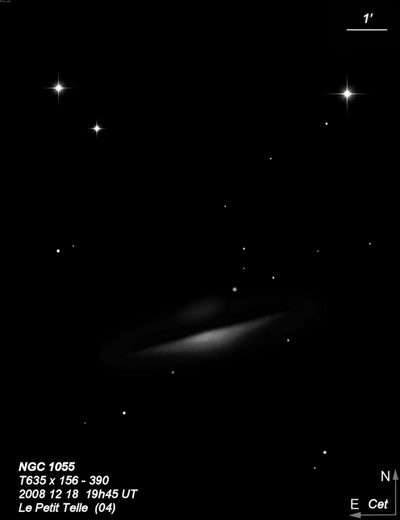
William Herschel discovered NGC 1055 = H I-1 = H II-6? = h258 on 19 Dec 1783 (early sweep 53?). His summary description (based on 7 observations) reads "cB, cL, iF, bM." He possibly found NGC 1055 the night before, noting H II-6 as "a small nebula. It is like a very small comet, not visible in the finder 1/2?." He estimated the position as roughly 1/2? north of Delta Ceti and later commented "This has probably been a telescopic comet, as I have not been able to find it again, notwithstanding the assistance of a drawing which represents the telescopic stars in its neighbourhood." In the 1912 revision of WH's catalogues, Dreyer suggested H. II 6 was equivalent to NGC 1055 and added the note "very rough sketch shows it in line with 2 stars preceding and one following." Steinicke, though, equates H. II 6 with a pair of stars at 02 40 19.5 +00 54 37 (2000), which fits Dreyer's comments.
200/250mm - 8" (11/8/80): faint, elongated. Located 30' NNW of M77.
300/350mm - 13" (9/3/83): fairly faint, elongated WNW-ESE. A mag 12 star is 1' N.
400/500mm - 17.5" (11/14/87): fairly bright, fairly large, very elongated 3:1 WNW-ESE, broadly concentrated halo. A mag 11 star is just off the NW flank 1.2' from the center. Located 7' SE of mag 6.8 SAO 110689 and 7' SW of mag 7.8 SAO 110692. Member of the M77 group.
900/1200mm - 48" (10/24/14): very bright, nearly edge-on spiral, spans ~6'x1.8' WNW -ESE. The bright central region extends 2'x0.5' and increases gradually towards the center. A relatively wide, prominent dust lane runs along nearly the entire northern flank of the galaxy!
The fainter portion of the galaxy on the north side of the dust lane was clearly visible paralleling the central region. Due to a slight tilt in edge-on orientation, the northern section of the galaxy is partially obscured and extended only ~1.6' in length and at most 30" in width. The glow terminates on its west side after reaching the mag 11.2 star just 1.2' NNW of center. Forms a wide pair (similar radial velocity) with M77 30' SSE.
Notes by Steve Gottlieb
NGC 45
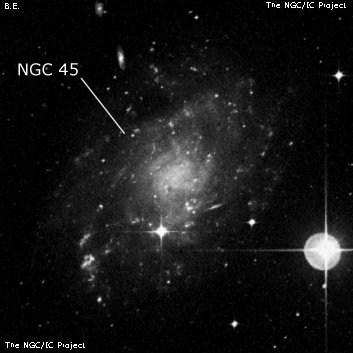
John Herschel discovered NGC 45 = h 2313 on 11 Nov 1835 and logged "extremely faint; large; round; very gradually very little brighter in the middle; attached to and nearly involving a large star; the following of two. A very faint object of singular appearance, 3 or 4' diameter; forms a kind of cometic appendage to the star, which, however, is quite at the edge." His position is 9 sec of RA west of ESO 473-001 (error corrected by Herbert Howe in 1900).
300/350mm - 13.1" (12/7/85): extremely faint, fairly large. A mag 7 star 4' WSW detracts from observation.
13.1" (8/24/84): only suspected at visual threshold. The nearby mag 7 star interferes with viewing.
400/500mm - 17.5" (8/2/86): faint, large, almost round, very diffuse. A mag 10 star (SAO 166133) is attached at the south end. Located 4' ENE of mag 6.9 HD 941. Both stars interfered with viewing!
NGC 45 is a low surface brightness, metal-poor spiral with a weak star formation rate. It resides in the background of the Sculptor Group at a distance of ~23 million l.y.
Notes by Steve Gottlieb
NGC 1087
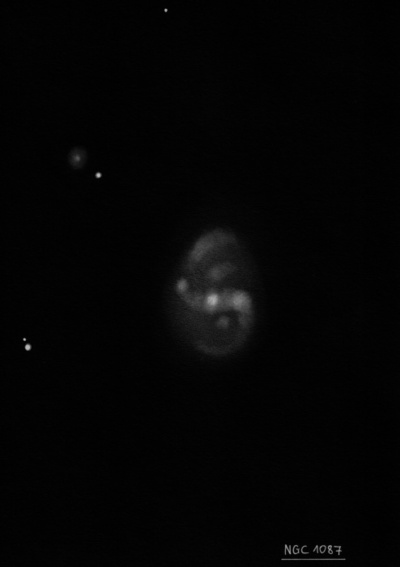
William Herschel discovered NGC 1087 = H II-466 = h265 on 9 Oct 1785 (sweep 463) and noted "pB, cL, R, mbM." A month later on 7 Nov 1785 (sweep 470) he logged "pB, pL, irr R."
Based on photos taken at the Helwan Observatoiry in 1919-20, the galaxy was described as "B, 3' x 1.5', E 10? ?, spiral with fairly sharp BN and about 20 bright, almost stellar condensations; the whols in south portion of nebula are fairly normal, but the north portion is rather curious."
200/250mm - 8" (12/6/80): faint, fairly small, diffuse. Located near a string of mag 10 stars.
300/350mm - 13.1" (9/3/83): fairly bright, moderately large, weak concentration, elongated N-S.
400/500mm - 17.5" (11/14/87): bright, fairly large, elongated 3:2 N-S, gradually brighter halo, small bright core. Two mag 11 stars 2.9' NE and 3.8' ESE of center are part of a string of brighter stars oriented NW-SE. NGC 1090 lies 15' NNE. Nearby MCG +00-08-012 was not seen.
Notes by Steve Gottlieb
NGC 210
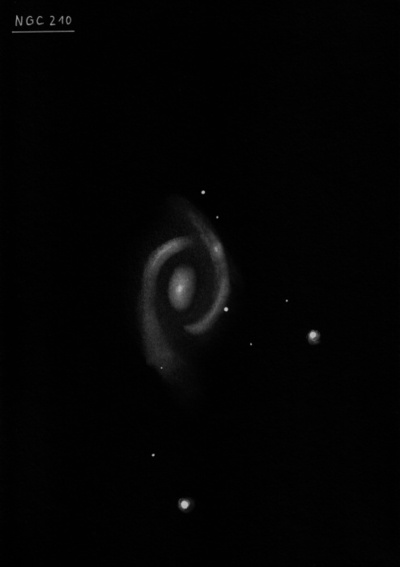
William Herschel discovered NGC 210 = H II-452 = h46 on 3 Oct 1785 (sweep 451) and recorded "pB, pS, mbM, resolvable, star 1.5' distant". His position is 30 tsec too far west.
R.J. Mitchell, LdR's observer on 7 Dec 1857, logged "bright centre; much elongated north and south, arms vF." Francis Leavenworth independently found the galaxy on 2 Oct 1886 at the Leander-McCormick Observatory and included it in the LM first discovery list (#11).
200/250mm - 8" (10/13/81): faint, small, round. A mag 9 star is 7' W.
300/350mm - 13.1" (8/24/84): fairly bright, fairly small, slightly elongated ~NNW-SSE, small very bright core. A mag 11.5 star is close WSW [1.3' from the center]. Located 7' E of mag 8.3 SAO 147392. Forms a pair with MCG -02-02-082 7.7' NE (not seen).
600/800mm - 24" (11/21/19): at 322x; the central region is bright, moderately large, oval 5:3 ~N-S, 1.2'x0.7'. Contains an intense roundish core that gradually increases to the center. With averted vision, a very large, low surface brightness halo - more easily visible on the south side - increased the size dramatically to nearly 4'x2'. Often the halo seemed like a ring as there was a dip in brightness surrounding the brilliant central region. The halo passes through a mag 12.6 star on the west side [1.2' from center].
Notes by Steve Gottlieb
NGC 864
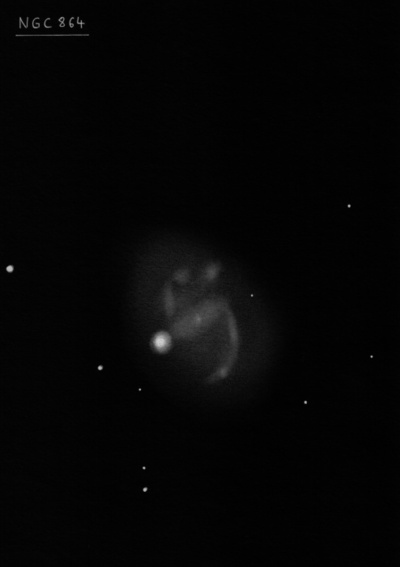
William Herschel discovered NGC 864 = H III-457 = h206 on 25 Oct 1785 (sweep 464) and noted "vF, cL, vlbM, milky, preceding a bright star and the nebulosity joining to it, but probably unconnected." John Herschel logged on 25 Sep 1830 (sweep 300), "eF; R; attached to and np a * 11.12 mag. Clouded before it could be fully verified." Despite the clouds, his position and description match.
300/350mm - 13.1" (9/3/86): fairly faint, oval SSW-NNE, even surface brightness. A fairly bright mag 11 star is at the following edge 43" ESE of the center.
600/800mm - 24" (12/6/18): at 260x; fairly bright interesting galaxy with a mag 10.7 star superimposed on the east side that detracts from viewing structure. Overall the galaxy is fairly large with an irregular halo roughly SW-NE, ~2.5'x1.8'. Contains a very bright, round nucleus and the brighter central region appeared extended WNW-ESE. A spiral arm on the west and south side appeared as a slightly enhanced "wing", mostly seen as an enhanced curving edge. The opposing arm was only a short and weak arc enhancement that extended north of the bright star.
900/1200mm - 48" (10/29/16): this striking two-armed barred spiral appeared bright, fairly large, overall elongated 3:2 SW-NE, well concentrated with a bright core. The core extends into a weakly defined bar WNW-ESE. A long thin spiral arm is attached to the west end of the bar and it curled gradually counter-clockwise to the south for nearly 90°, ending due south of the core [separation 1.2']. A bright mag 10.7 star is superimposed on the east side [44" ESE of center]. The second spiral arm was not as easily seen as it begins just inside (west) of the bright star, which detracted from the view. This thin arm extended straight north, roughly at a right angle to the bar and merged into the halo on the northeast side. UGC 1775 = Arp 10 is 49' SE.
Notes by Steve Gottlieb
NGC 1042
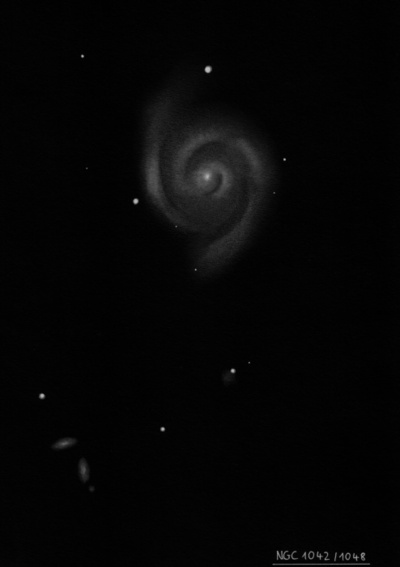
Lewis Swift discovered NGC 1042 = Sw. III-17 on 10 Nov 1885 with the 16" Clark refractor at Warner Observatory and reported "eeF, L, R, np of 2 [with NGC 1052]". In his 5th discovery list, Swift corrected the description to read "sp of 2" [with NGC 1052]. Based on a photograph taken with the Reynolds reflector at the Helwan observatory in the late 1920s, NGC 1042 was described as an "open spiral with a pF stellar Ncl, well defined [arms] with some [knots]."
300/350mm - 13.1" (9/3/86): very large but diffuse, only a very weak concentration.
13.1" (9/9/83): large, very diffuse, no central brightening, irregularly round, best at 62x (too large and diffuse for higher power).
400/500mm - 17.5" (11/1/86): very large, very diffuse low surface brightness system best viewed at 83x or 133x. Almost round, slightly brighter on the SE end with either a very faint star(s) superimposed or a brighter knot. Forms a pair with NGC 1048 (double system) 6' SSE and NGC 1052 lies 14' NE.
900/1200mm - 48" (10/26/16): at 488x; bright, very large, face-on spiral with a small bright core and a relatively small weak bar oriented ~NW-SE. Low contrast spiral structure was visible around the core. Most prominent, though, was an outer spiral arm along the east side, which swept N-S in a gentle arc. It was brightest just to the west of a mag 13.6 star [SDSS reveals numerous HII knots] situated 1.6' SE of the core. The outer spiral arm along the western edge was more diffuse and ill-defined, passing just east of a 16th magnitude star 1.7' WSW of the core.
Notes by Steve Gottlieb
NGC 1073

William Herschel discovered NGC 1073 = H III-455 on 9 Oct 1785 (sweep 463) and recorded "vF, vL, lbM, 6 or 7' diameter". He noted it was "easily resolvable" on a later sweep. The mottling he noted is due to numerous HII knots.
200/250mm - 8" (11/28/81): very faint, fairly large, very diffuse, round. Three mag 10 stars are close SW.
300/350mm - 13.1" (9/3/83): fairly faint, large, even surface brightness, round. An equilateral triangle consisting of three mag 9.5-10.5 stars with sides 5' lies SW.
900/1200mm - 48" (10/24/14): at 488x; the central bar is very bright and well-defined, extending 1.0'x0.3' SW-NE. An easily visible spiral arm is attached at the northeast end of the bar and extends at a right angle to the northwest, passing through a mag 16 star [50" N of center]. The arm then dims but sweeps clockwise around the west side, and merges with the second arm attached at the southwest end of the bar. As a result, the galaxy appears to have a single continuous arm rotating ~270? and ending on the southeast side, ~1.2' from center! The outer part of the halo has a low surface brightness but extends at least 4' in diameter. Another mag 16 star is on the southwest side of the halo [1.4' from center].
At least three HII complexes were identified. The brightest is NGC 1073:[HK 83] 6/9, an elongated patch ~13"x8" E-W, situated at or just beyond the southeast end of the spiral arm [1.4' from center]. A small, fainter knot close west, [HK83] 19, was difficult to resolve. [HK83] 69, a faint 10" knot, is on the west side of the halo (beyond the arm) [1.4' due west of center]. Finally, [HK83] 49 is a third 10" knot of low contrast in the northwest outer halo [1.9' NNW of center]. The designations are from Hodge and Kennicutt's 1983 "An Atlas of HII Regions in 125 Galaxies".
Notes by Steve Gottlieb
NGC 779
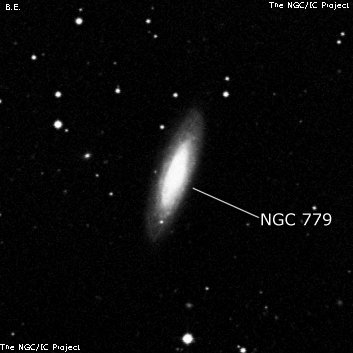
William Herschel discovered NGC 779 = H I-101 = h183 on 10 Sep 1785 (sweep 436) and logged "cB, pL, mbM, E a few degrees deviating from the meridian; from np to sf." John Herschel observed the galaxy on 3 sweeps, including 2 Jan 1827 (sweep 40): "pB; pL; E; pos about 160° by diag." His position angle and position is accurate.
200/250mm - 8" (10/13/81): fairly bright, bright core, edge-on N-S.
400/500mm - 17.5" (11/27/92): bright, fairly large, very elongated 3:1 NNW-SSE in PA 160°, 3.0'x1.0', brighter core, substellar nucleus. A mag 11 star is 4.6' SSW of center.
900/1200mm - 48" (10/24/14): extremely bright, very large, nearly edge-on 7:2 NNW-SSE, 3.5'x1.0'. Contains an intensely bright, mottled core and nucleus. The core is within a brighter, elongated "bar". The outer halo appears to extend further to the south with averted vision and bend slightly with respect to the central region. The northern end of the halo has a similar effect as if the galaxy is very slightly warped.
Notes by Steve Gottlieb
NGC 1032
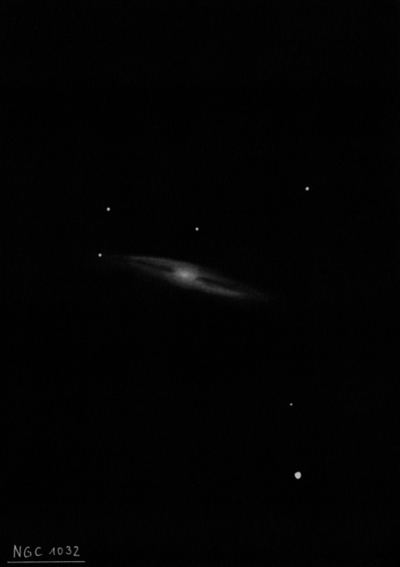
William Herschel discovered NGC 1032 = H II-5 = h246 on 18 Dec 1783 (early sweep 47) and noted "vF, S, like a small comet, 3/4? above Delta Ceti." On 7 Nov 1785 (sweep 470), he called it "the nebula in the quartile. It is not quite R, but lE having vF rays sp and nf." His summary description (from 8 sweeps) reads "pB, S, lE, bM." This was first object WH found with the telescope moving vertically only and using reference stars as they passed through the eyepiece. NGC 1032 was his 10th overall deep sky discovery (according to his internal numbering). LdR's 1861 publication mentions "Spirality suspected".
200/250mm - 8" faint, small, very elongated WSW-ENE, weak concentration. Four mag 13 stars to north including one 1.8' NE.
400/500mm - 17.5" (10/29/94): fairly bright, fairly large, very elongated 4:1 WSW-ENE, 2.5'x0.6'. Dominated by a bright core which is broadly concentrated and contains a faint stellar nucleus. The extensions are smooth and unconcentrated. A mag 12.5-13 star is at the ENE edge 1.4' from the center and two mag 13 stars are along the north side (1.8' NE and 1.3' NNW of center) forming a right triangle.
900/1200mm - 48" (10/26/11): at 385x and 488x appears very bright, large, very elongated 4:1 WSW-ENE, 3.0'x0.8'. Well concentrated with a prominent, bulging oval core that brightens towards the center and long, thin, fainter tapering extensions that dim at the tips. A mag 13 star is at the tip of the ENE extension. The visual treat, though, is a razor thin dust lane that clearly bisects the large central buge. As the much fainter extensions start to taper down, the dust lane loses contrast and disappears towards the ends.
Notes by Steve Gottlieb
NGC 337
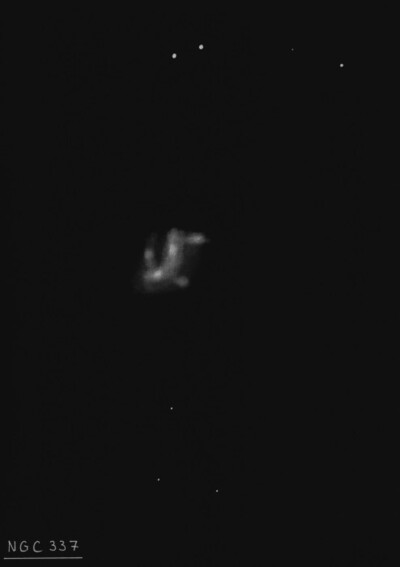
William Herschel discovered NGC 337 = H II-433 = h80 on 10 Sep 1785 (sweep 435) and noted "pB, pL, bM, irregular parallelogram in the direction of the meridian." His position is pretty accurate.
R.J. Mitchell observed this irregular galaxy using LdR's 72" on 3 Oct 1856 and recorded "pL, not vF. Its brightest part is a line running diagonally, and there is a knot at either end. Perhaps it shaped like an "S". The galaxy has a distorted appearance on CCD photo.
300/350mm - 13.1" (9/29/84): fairly bright, moderately large, elongated NW-SE, fairly even surface brightness, diffuse outer halo. A mag 11.5 star is 5.4' E of center.
400/500mm - 17.5" (12/26/00): fairly bright and large, elongated 3:2 NW-SE, ~1.8'x1.2', broad concentration. The appearance is asymmetric -- with a noticeably mottled or irregular surface brightness. Brighter knots within the halo are also clearly visible at moments. The visual impression matches well with the DSS image, which shows a chaotic structure with a number of large HII knots. NGC 337A, a large faint dwarf spiral, lies 27' E.
900/1200mm - 48" (11/1/13): at 488x appeared bright, fairly large, very irregular with a number of obvious clumps. Although the galaxy is generally elongated 3:2 or 5:3 NW-SE it contains a bright, elongated N-S central region that seems to be a bar. On the south end of the "bar" is a brighter elongated patch extending towards the WSW. Another brighter knot is at the north end of the bar, extending to the east. On the southeast flank of the galaxy is an elongated, fainter patch. The northwest side of the halo extends further out, giving an asymmetric outline, and one or two small knots are involved. A mag 11 star lies 5' E.
Notes by Steve Gottlieb
NGC 157
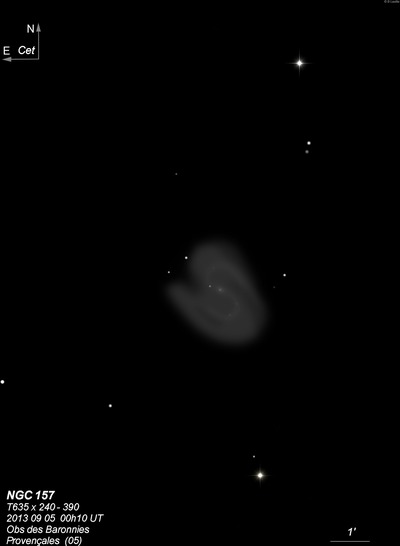
William Herschel discovered NGC 157 = H II-3 on 13 Dec 1783 (sweep 44) and recorded "F, L, mE, between two considerably bright stars." His position was not accurately determined but his description is a perfect match with MCG -02-02-056 = PGC 2081. Eduard Schönfeld, Heinrich d'Arrest and Father Secchi provided accurate positions, so the NGC position is correct. Édouard Stephan (IX-1) independently found the galaxy with the 31" reflector at Marseille on 28 Oct 1878.
200/250mm - 8" fairly faint, fairly large, diffuse. Located between two mag 8.5/9.5 stars to the north and south.
400/500mm - 17.5" (9/17/88): bright, large, oval 3:2 SW-NE, broad concentration, small bright core, mottled appearance, sharp edge along the east side. Two mag 13.5 and 15 stars are near the NE edge. The galaxy is bracketed between 9.5-mag HD 3154 5.5' S and 8.6-mag HD 3144 6' NNW.
900/1200mm - 48" (10/29/19): at 610x; showpiece spiral with the sweep of two prominent spiral arms, outlined by dust lanes, forming a striking, stretched "S" pattern, similar to Superman's logo! Overall, elongated 3:2 SW-NE, ~3'x2'. At the center was a very small, intense nucleus. A beefy spiral arm was attached at the west side of the nucleus. It showed a high contrast, due to inner and outer dust lanes with a brighter, curving arc at its southwest end. This arm rotated clockwise towards the southeast side, and hooked towards the northeast. The second thick arm as attached on the east end of the nucleus. It also showed a high contrast arc along its northeast portion, then rotated sharply clockwise towards the west and angled southwest to the west of the central region. Two mag 13.6/15.3 stars (0.6' apart) lie 1.3' NE of center. A dusty triangular wedge (between spiral arms) extended from these stars towards the core.
Notes by Steve Gottlieb
NGC 578
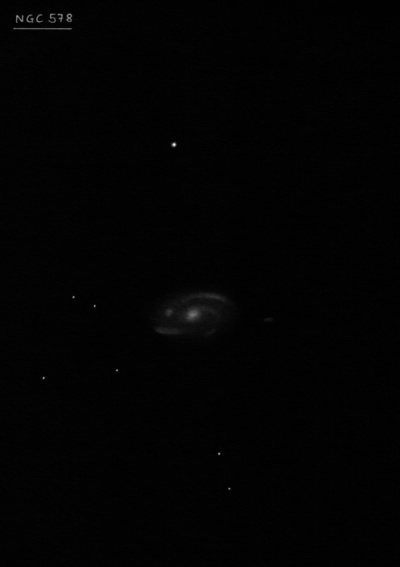
John Herschel discovered NGC 578 = h2418 on 11 Nov 1835 and logged "B; L; pmE; gpmbM; 3' long, 2' broad." His position is accurate.
200/250mm - 8" (9/25/81): faint, fairly large, elongated. Lies SE of a mag 8 star.
400/500mm - 17.5" (1/1/92): fairly faint, fairly large, elongated 4:3 WNW-ESE, ~4'x3', slightly brighter middle is mottled, no distinct core. A mag 14 star or knot is at the east end 1.3' from the center. The SDSS image reveals this is a galaxy, catalogued as PGC 133775. Located 11' SE of mag 7.8 SAO 81972.
Notes by Steve Gottlieb
NGC 428
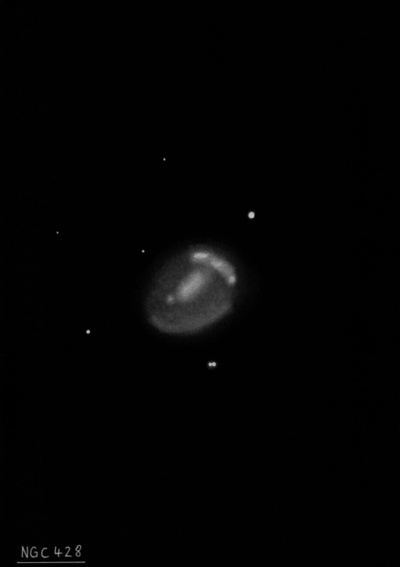
William Herschel discovered NGC 428 = H II-622 on 20 Dec 1786 (sweep 655) and noted "F, R, bM, easily resolvable." Heinrich d'Arrest measured an accurate micrometric position on 30 and 31 Oct 1864.
300/350mm - 13.1" (9/3/86): fairly bright, moderately large, oval ~N-S, weak concentration. A mag 13 star is at the NW edge 1.8' from center. Forms the vertex of an isosceles triangle with two mag 8.5 stars SAO 109728 and SAO 109733 6.0' W and 6.0' NNE, respectively.
600/800mm - 24" (12/22/14): bright, fairly large, elongated 4:3 ~NW-SE, mottled irregular appearance, broad weak concentration. With averted vision the halo increases in size to ~2.5'x2.0'. A quasi-stellar HII region, catalogued in NED as UM 309 NED1 and NGC 428: [HK83] 44-46, occasionally pops as a very small detached knot, ~6" diameter. This is the brightest in a series of blue HII knots on the northwest side of the outer core [45" WNW of center]. NGC 428 forms the southeast vertex of an isosceles triangle with mag 8.7 HD 7208 6' W and mag 8.6 HD 7276 8' NNE. Mag 12.5 stars are 2' NW and 2' SSW [6" pair].
Notes by Steve Gottlieb
NGC 151
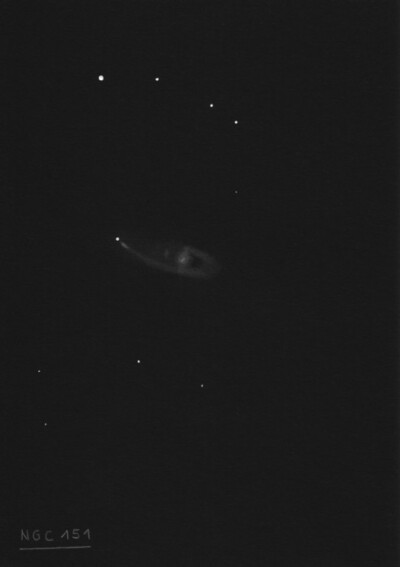
300/350mm - 13.1" (8/24/84): fairly bright, bright core, very bright nucleus, very faint halo elongated ~E-W. A faint star is at the ENE edge.
400/500mm - 17.5" (9/17/88): moderately bright, moderately large, oval 5:3 WSW-ENE, 2.5'x1.5', bright nucleus. A mag 13 star is at the ENE edge, 1.7' from the center.
600/800mm - 24" (12/1/16): bright, fairly large, contains a very bright boxy rectangular central section that is slightly elongated NNW-SSE (this is the central bar and nucleus), encased by a fairly low surface brightness halo extended at least 2:1 E-W, ~2.7'x1.2'. A mag 12.5 star is at or just off the ENE edge (1.7' from center). A superimposed companion is at the tip of the eastern spiral arm of the galaxy, very close southwest of the mag 12.5 star. It was marginally glimpsed but only occasionally popped.
900/1200mm - 48" (10/29/19): very bright striking spiral with an inner ring and a long, drawn out spiral arm! Overall, at 610x the galaxy extended over 2:1 WSW-ESE, ~3.2' x 1.4'. Very strongly concentrated with a very bright core that gradually increased to the center. Immediately west of the core was a noticeably darker gap and a lower contrast gap was east of the core. These gaps were outlined by bright arcs, each about 90°, creating a partial oval ring surrounding the core.
The western half of the halo had a low surface brightness and extended at least 1.5' from the center. I noticed a brightening at the extreme west end of the halo. Checking the SDSS, this is a split spiral arm, separated beyond a darker dust lane. A thin, long spiral arm was attached at the south side of the core (along the inner ring) and was easily seen gently curving northeast, extending directly to a mag 12.6 star!
A small, faint knot, at most 10" diameter, was easily seen near the end of this arm, very close SSW [16"] of the mag 12.6 star. This "knot" is a companion galaxy (2MASX J00340814-0941481), though its redshift is 1/3 greater than NGC 151, so it may be in the background.
Notes by Steve Gottlieb
NGC 895
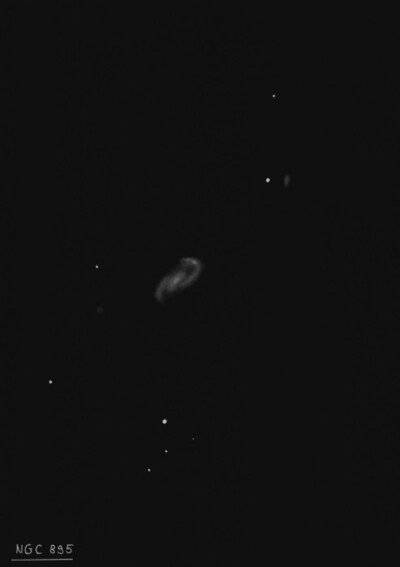
William Herschel discovered NGC 895 = H II-438 = h219 on 10 Sep 1785 (sweep 436) and commented "pB, pL, irr figure, mbM." On 5 Oct 1785 (sweep 456), he noted "F, vL, irr figure, r, unequally bright." The northwest spiral arm (discovered at Birr Castle) is catalogued separately as NGC 894. See historical notes on NGC 894.
400/500mm - 17.5" (8/31/86): fairly bright, large, broadly concentrated halo, diffuse halo. A mag 14 star is off the following edge, 2.0' ENE from the center and a mag 12 star is 4.7' S.
Notes by Steve Gottlieb
NGC 274
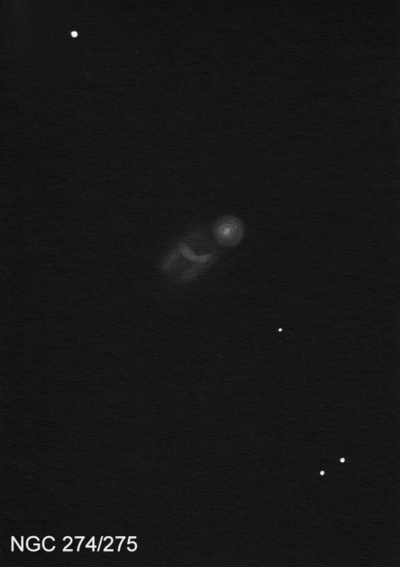
William Herschel discovered NGC 274 = H III-429 = h69 on 10 Sep 1785 (sweep 435), although he only noted a single object as "vF, pS, E."
The pair was observed 8 times with Lord Rosse's 72-inch. On 3 Oct 1856, observer R.J. Mitchell's wrote, "69 [NGC 274] is S, B, R, with bright nucleus; 70 [NGC 275] is F, E and patchy. Suspect formed of two knots involved in faint nebulosity; there appears to be a nebulous connexion between them all." On 15 Nov 1857, Lord Rosse experimented with a silvered secondary (the speculum secondary was covered with a thin silver layer) and noted "silvered mirror shows the object brighter than before, but no new details.”
300/350mm - 13.1" (9/29/84): moderately bright, small, compact, very small bright core. Forms a close pair with NGC 275 1' SE.
600/800mm - 24" (10/5/13): bright, round, fairly small, 0.6' diameter, sharply concentrated with a small intensely bright core that gradually increases to the center, but no nucleus. This is the brighter but smaller component of a striking double system (Arp 140 = VV 81) with NGC 275, which is attached on the SE side. NGC 273 lies 11' NNW.
Notes by Steve Gottlieb
NGC 450
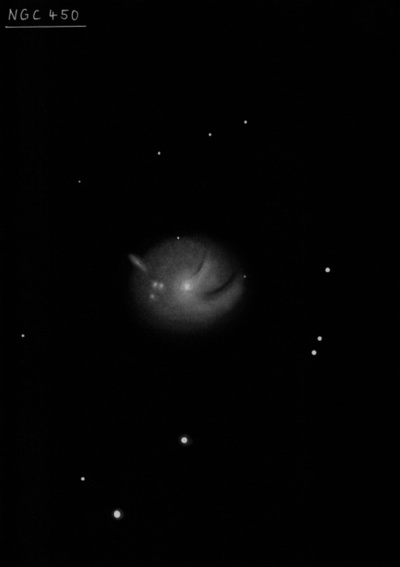
William Herschel discovered NGC 450 = H III-440 on 1 Oct 1785 (sweep 448) and logged as "vF, vL, requires great attention." His RA was 25 tsec too large, but Heinrich d'Arrest provided an accurate position used in the NGC. This system is a noninteracting spiral pair with the companion (UGC 807) over 6 times as distant.
300/350mm - 13.1" (9/3/86): very large, diffuse, broad concentration, slightly elongated. Located 12.5' NE of 38 Ceti.
900/1200mm - 48" (10/22/11): at 610x this double system is dominated by NGC 450, which appeared bright, large, 2.3' diameter. Sharply concentrated with a relatively large 30" bright core, surrounded by a very large, low surface brightness halo. The halo is slightly asymmetric and more extensive on the west side.
Three faint "stars" are superimposed on the east side of the galaxy; two appeared stellar, but the faintest and most westerly object was clearly "soft" at 610x. These are apparently HII knots in the galaxy and the southeast object is listed in NED as UM 311 from the University of Michigan Emission Line Survey.
NGC 450 has a very close companion, UGC 807, which is attached at the northeast side of the halo, 1.4' between centers. UGC 807 appeared fairly faint, fairly small, elongated 5:2 SW-NE, 0.7'x0.3', even surface brightness except for a very small brighter nucleus. Despite the fact that UGC 807 appears to form a double system, the companion has a redshift that is over 6x greater than NGC 450, so they are a line-of-sight pair.
Notes by Steve Gottlieb
NGC 245
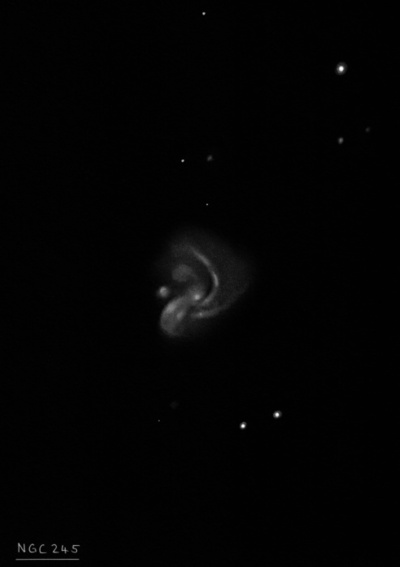
William Herschel discovered NGC 245 = H II-445 on 1 Oct 1785 (sweep 448) and recorded "F, iR, easily resolvable, 1' broad." The NGC RA is just 0.1 tmin too large.
300/350mm - 13.1" (9/29/84): moderately bright, slightly elongated WNW-ESE, star superimposed or faint stellar nucleus.
400/500mm - 17.5" (10/8/88): moderately bright, moderately large, slightly elongated ~E-W, stellar nucleus. A pair of stars mag 13.5 and 14.5 with a separation of 35" lie 1.5' S.
Notes by Steve Gottlieb
NGC 191
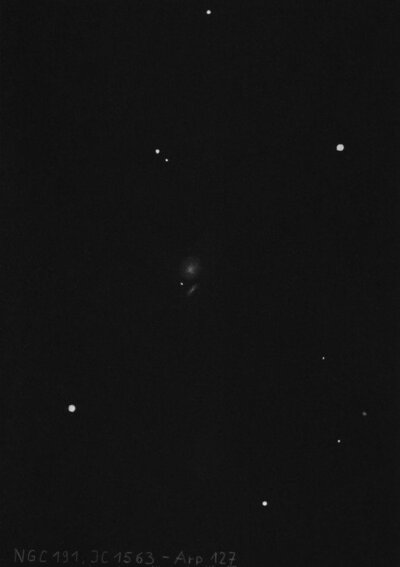
William Herschel discovered NGC 191 = H II-479 = h38 on 28 Nov 1785 (sweep 479) and logged "pB, mE nearly in the meridian, near 2' long". Sir Robert Ball, using Lord Rosse's 72" on 12 Dec 1866, recorded "One neb, with either 2 stars or B, S, neb knots very closely foll - cB, pL, R, bM, two pB st preceding." One of these "knots" is IC 1563, although discovery credit is given to Bigourdan in the IC. The NGC position is accurate.
400/500mm - 17.5" (9/17/88): close double system with IC 1563 0.6' SE. Fairly faint, very small, round. A mag 14 star is 30" SE of center. A very faint halo surrounding the core extends to IC 1563 and the mag 14 star. IC 1563 appeared faint, very small, round.
Notes by Steve Gottlieb
NGC 145
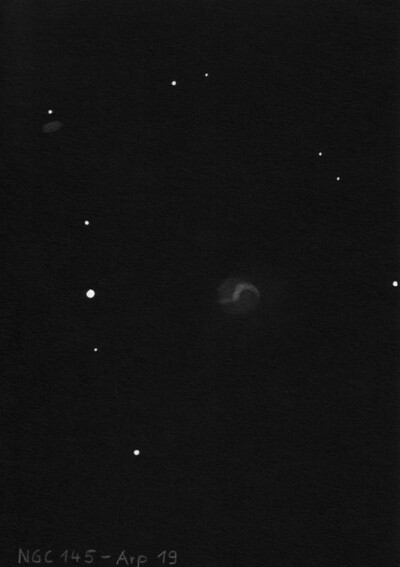
John Herschel discovered NGC 145 = h27 = h2328 on 9 Oct 1828 and recorded "vF; vlE; glbM, 60" long." His position is accurate.
400/500mm - 17.5" (9/17/88): fairly faint, moderately large, oval ~E-W, small bright core. Located 6' WNW of mag 8.7 SAO 128813. This star is situated within a string oriented SW-NE with a mag 10 star 7' SSE of NGC 145 forming the southwest end of this string. The northeast end of the string intersects a shorter line of four mag 11-12 stars.
900/1200mm - 48" (11/8/15): at 375x and 488x; fascinating irregular spiral galaxy. A bright bar extends 30" N-S. A spiral arm is attached at the north end of the bar and is easily visible extending to the west, and curling clockwise. The arm has a fairly high contrast and definition. A small HII knot (~8" diameter) is nearly attached to the north end of the bar where the spiral arm begins. A fainter, low contrast arm is attached at the south end of bar and extends 30" due east.
Two companions were picked up. PGC 1048844 is 3.1' NE. At 488x it appeared fairly faint (V = 16.0), small, roundish, 15" diameter. PGC 1048201 (not catalogued in Megastar) appeared faint (V = 17.1), very small, round, 12" diameter.
Notes by Steve Gottlieb
NGC 942
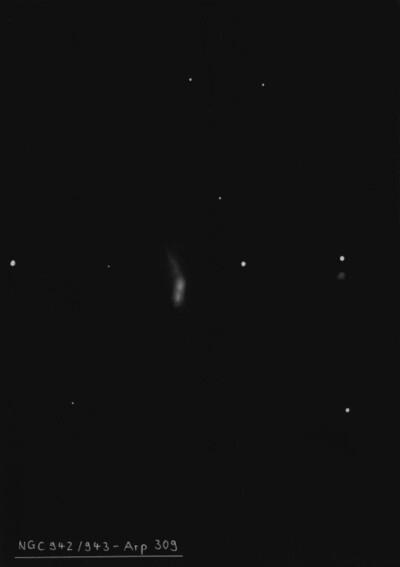
Frank Muller discovered NGC 942 = LM 1-53, along with NGC 943, in 1886 with the 26" refractor at Leander McCormick Observatory. He described both as a "nebulous double star?" His rough position is a close match with MCG -02-07-018 = PGC 9458, the southeastern member of the pair. Herbert Howe measured accurate positions for the pair in 1897 using the 20" refractor at Chamberlin Observatory as well as Sherburne Burnham (Publ of Lick Observatory, II).
In March 2020 Yann Pothier found the original discovery of NGC 942 and 943 was made by LdR assistant Ralph Copeland on 31 Jul 1872. He recorded "Double in position 159.0°, distance of nuclei = 40".4; both are R; psbM but the np is slightly larger than the other. Position of a 12m * from the brighter of the nebulae = 286.4°, distance = 139.3". But Copeland assumed he was observing NGC 945, discovered by William Herschel, and furthermore provided no coordinates or reference for Dreyer to compute a position.
400/500mm - 17.5" (12/4/93): this is the slightly brighter southern member of a double system with NGC 943. Appears faint, very small, round. Increases to a small brighter core and faint stellar nucleus. NGC 943 is just 30" N and both galaxies appear immersed in a common halo. NGC 950 lies 12' S.
600/800mm - 24" (12/22/14): NGC 942 is the slightly brighter and southern component of a close double system with NGC 943. At 375x it appeared moderately bright, small, slightly elongated, 0.4'x0.3'. Well concentrated with a very small, very bright core and stellar nucleus. NGC 943 is just 30" SSE (between centers) and within a common halo.
IC 230 (discovered by S.W. Burnham in 1891) lies 5.5' due west and appeared faint to fairly faint, small, round, 12"-15" diameter. Easily seen despite a mag 15.7B.
Notes by Steve Gottlieb
NGC 1141
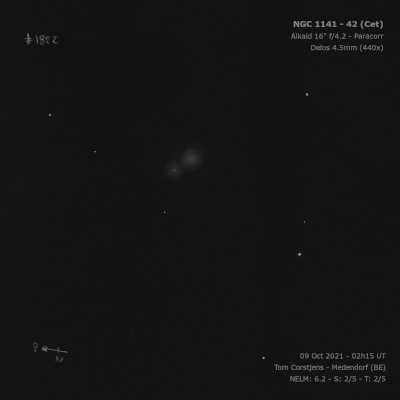
?douard Stephan found NGC 1143 = St VIIIa-11 (along with NGC 1144 = St VIIIa-10) on 17 Nov 1876 with the 31" reflector at Marseille Observatory. His position is accurate. This galaxy was first discovered by Marth on 5 Jan 1864 but his position was 40' too far N (also NGC 1142), so he did not receive credit. But it clear that NGC 1143 = NGC 1141 and NGC 1144 = NGC 1142.
400/500mm - 17.5" (1/7/89): very faint, very small, round. In a common halo with NGC 1144 0.5' ESE. This galaxy is the slightly fainter of the pair.
900/1200mm - 48" (10/25/11): bright, fairly small to moderately large, oval 4:3 WNW-ESE, 0.9'x0.7', well concentrated with a very bright, intense core! Slightly fainter of an interacting pair with highly disrupted NGC 1144, just 35" between centers. The eastern portion of the outer halo of NGC 1143 is merged or overlaps with the halo of NGC 1144 on its northwestern side. 2MASX J02550661-0009448, listed as a 2nd "collider" with NGC 1144 in Madore's 2009 Atlas and Catalogue of Collisional Rings, lies 1.2' NW. The 2MASS galaxy appeared fairly faint, small, very elongated 3:1 N-S, 0.4'x0.15', stellar nucleus.
Notes by Steve Gottlieb
NGC 702
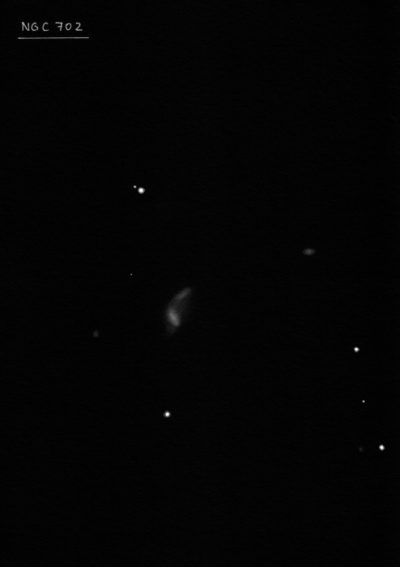
Arp classified NGC 702 (Arp 75) as a spiral with "small high surface-brightness companion on arms", though this appears to be a bright emission region. The core of this galaxy, though, may contain two close nuclei so NGC 702 might be a post-collisional system.
William Herschel discovered NGC 702 = H III-192 = h158 on 20 Sep 1784 (sweep 280) and noted "eF, S, 240 verified it with difficulty." John Herschel observed the galaxy on 3 sweeps and logged on 18 Oct 1827 (sweep 97), "eF; lE in meridian; has a * 14m 90" south."
400/500mm - 17.5" (11/6/93): fairly faint, fairly small, elongated 3:2 NNW-SSE, small bright core, stellar nucleus. Located 10' NNW of mag 7.3 SAO 129535.
Notes by Steve Gottlieb
NGC 1044
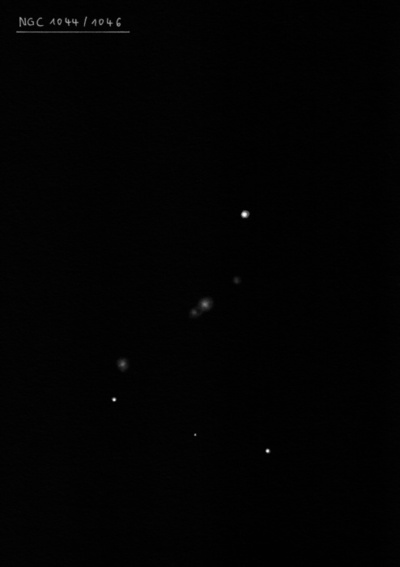
William Herschel discovered NGC 1044 = III-228 = h251, along with NGC 1046, on 7 Nov 1784 (sweep 308) and noted "eF, vS, 240 power confirmed it. Another still smaller and fainter about 1' following NGC 1046]." John Herschel measured a fairly accurate position on 8 Jan 1828 (sweep 118) and wrote "vF the p[receding] of two; a * 10m, p[receding] in same line.".
400/500mm - 17.5" (10/29/94): fairly faint, fairly small, elongated 3:2 WNW-ESE, broad concentration to a large brighter core. A mag 11 star lies 2.3' NW. Brightest of a collinear compact trio with NGC 1046 2.0' SE and MCG +01-07-022 = CGCG 414-036 off the NW edge 57" from the center (logged as "very faint, extremely small, round"). NGC 1044 appears larger than the listed dimensions probably due to the combined glow with an unresolved contact companion (PGC 3080165) at the SE edge. The four galaxies are very nearly on a straight line.
600/800mm - 24" (1/31/14): NGC 1044 is a double system with fainter LEDA 3080165 barely off the SE side. At 375x it appeared fairly faint, fairly small, slightly elongated, 24"x20", gradually increases to a sub-stellar nucleus. PGC 3080165 is attached at the SE side [19" between centers]. The companion was faint, extremely small, round, 8" diameter. This pair is flanked by CGCG 414-36 1.0' NE (noted as "faint, very small, round, 10" diameter") and NGC 1046 2.0' SE, with the collinear quartet spanning 3.0'. The four galaxies have identical redshifts, though there is no sign of interaction on the DSS.
Notes by Steve Gottlieb
NGC 235
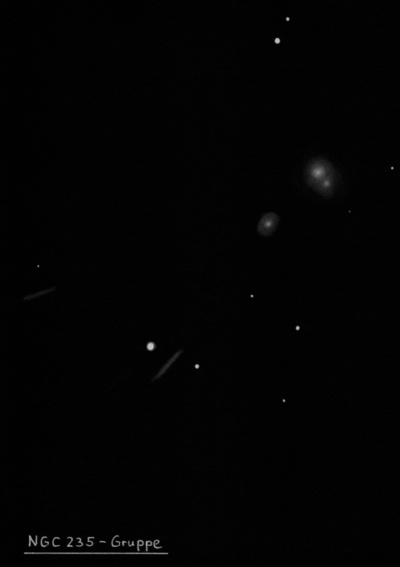
Francis Leavenworth discovered NGC 235 = LM 2-293, along with NGC 230 and 232, in 1886 with the 26" refractor at the Leander McCormick Observatory. His position is 0.3 min of RA east of ESO 474-016 = PGC 2569. This is a double system with the brighter component on the NW side, although it was not resolved by Leavenworth. Often NGC 235 is taken as the northwest component with the southeast component (ESO 474-017) a separate galaxy, though Leavenworth likely observed the merged image of both objects. MCG labeled the two galaxies as NGC 235A and 235B but PGC as NGC 235 and 235A. Herbert Howe measured an accurate position in 1898-99 using the 20" refractor at Chamberlin Observatory (repeated in the IC 2 notes), but also makes no reference to it appearing double.
400/500mm - 17.5" (12/3/88): the western member of this double system appeared faint, very small, round, small bright core. The eastern component, attached at the following end, appeared extremely faint and small, round. Forms a double with NGC 232 2.5' SW.
600/800mm - 24" (12/22/14): at 260x; NGC 235A, the brighter northwest component of this interacting double system, appeared fairly bright, fairly small, round, 24" diameter high surface brightness, bright core increases to a very bright stellar nucleus. NGC 235B is attached on the southeast side and appeared fairly faint, small, 12" diameter, round, very small brighter nucleus. The pair of galaxies are separated by just 20" between centers!
Notes by Steve Gottlieb
UGC 1775
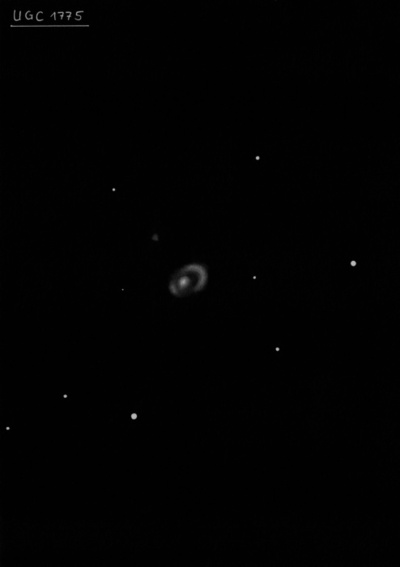
900/1200mm - 48" (10/29/16): at 488x; the Ring galaxy Arp 10 is unusually sharply concentrated with a blazing core that's offset to the southeast side. A brighter arc is at the northwest end of the halo (ring segment). A very weak enhancement at the southeast end blends into the glow on the southeast end of the galaxy. LEDA 3635229, initially presumed to be the collider, is a background galaxy at a light-travel time of 1.175 billion years, lies 1.1' NE. It appeared faint, very small, elongated 3:2 N-S, ~15"x10".
48" (10/23/11): this collisional ring galaxy was viewed at 488x. It appeared sharply concentrated with a very bright, round core 0.3' diameter. The core is offset to the SE side of a much fainter and the halo is slightly elongated NW-SE, 0.9'x0.7'. A 90? bright arc (part of the ring!) was easily visible on the northwest edge of the halo. A 1993 study in AJ, 414, 154 by Charmandaris, Appleton and Marston showed this arc consists of a number of HII knots and strong star formation. A mag 14.8 star lies 1.3' W and a mag 13.5 star is 2' SW.
Notes by Steve Gottlieb
NGC 7828
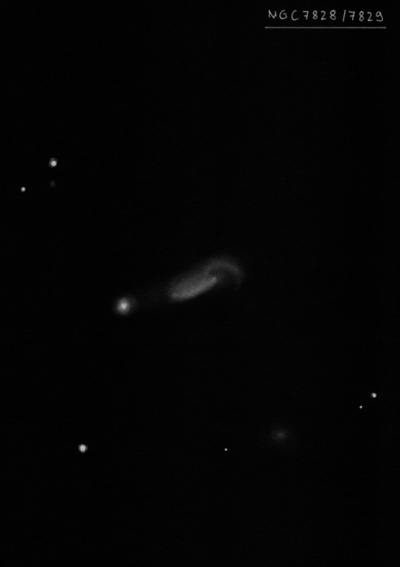
Francis Leavenworth discovered NGC 7828 = LM 2-274, along with NGC 7829, in 1886 and recorded "mag 15.4; 0.5' dia; pE 130° sbMN; * 15 NGC 7829] sf 3 seconds; Double [with NGC 7829], PA 100° at 0.3' separation." Howe measured an accurate position in 1897 at Denver (given in the IC 2 Notes).
In the Arp catalogue, NGC 7828 has a very unusual distorted appearance. According to Higdon (1988), this is not a classical ring but possibly the result of stripping of the gaseous disk from a spiral galaxy during the collision with an intergalactic HI cloud. It was rejected as a ring galaxy in "Stellar Disks of Collisional Ring Galaxies" (AJ 136, 1259,2008) by Romano et al.
400/500mm - 17.5" (9/15/90): faint, fairly small, elongated 2:1 NW-SE, even surface brightness. Forms a double system with NGC 7829, an extremely compact galaxy off the SE end.
900/1200mm - 48" (10/23/14): at 488x; fairly bright, moderately large, elongated 5:2 NW-SE, 40"x18", irregular shape with a mottled or clumpy appearance, slightly brighter along with south side. The galaxy displayed an extension or bend (slightly north) on the northwest side as if it consisted of two merged galaxies. A fainter 15" knot or patch is attached.at the northwest end. NGC 7828 forms an interacting pair (Arp 144 = VV 272) with NGC 7829 just 0.6' between centers. Arp 51 lies 3.2' SW and appeared fairly faint, fairly small, slightly elongated ~SW-NE, 24"x20".
Notes by Steve Gottlieb
NGC 17
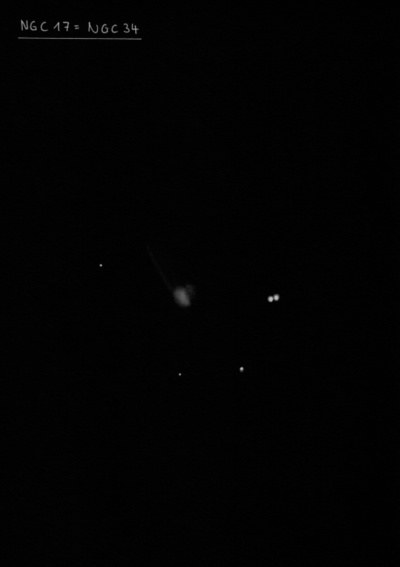
This LIRG (infrared-luminous galaxy) is an advanced-stage merger with a tidal tail to the NE.
Lewis Swift discovered NGC 34 = Sw. VI-1 on 21 Nov 1886, along with NGC 35, with a 16" refractor at Warner Observatory. His position and description ("equilateral triangle with 2 stars, one a close double") matches MCG -02-01-032 = PGC 781. Frank Muller independently found this galaxy in 1886 and reported it in his list II-276 (later NGC 17). His position was 2.0 minutes of RA too far west, but the description matches. So, NGC 34 = NGC 17 (discovery priority unknown). Herbert Howe searched for NGC 17 unsuccessfully with the 20" refractor at Denver and concluded it was equivalent to NGC 34 based on the similar descriptions.
400/500mm - 17.5" (8/20/88): moderately bright, small, round, bright core, stellar nucleus. A close double star (WZ 1 = 12.4/13.9 at 7") is 2' W. Forms a pair with NGC 35 6' NNE.
Notes by Steve Gottlieb
IC 1756
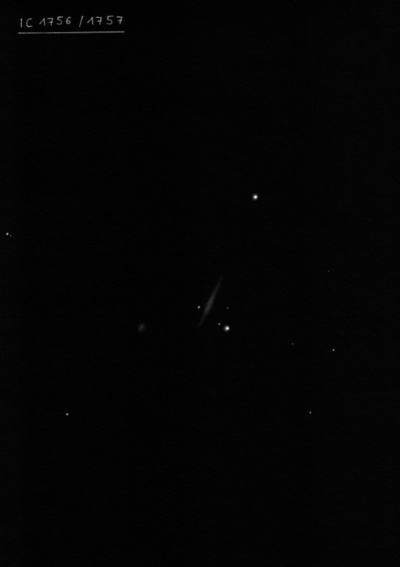
IC 1757, which lies far in the background at 1.1 billion l.y., lies 1.5' E.
E.E. Barnard discovered IC 1756, along with IC 1757. The discovery date and telescope is unknown as he communicated the discovery directly to Dreyer, but he was probably observing with the Lick 36-inch refractor. The MCG misidentified this galaxy (MCG +00-06-005 as being IC 1757. The MCG error is mentioned in the UGC Notes to UGC 1429 = IC 1756.
600/800mm - 24" (9/28/19): at 322x; very faint, fairly small, very elongated 4:1 NNW-SSE, ~40"x10", low even surface brightness, no core. A mag 14 star is at the southeast edge and galaxy is a dim streak extending mostly NNW from the star. A mag 13.7 star is 1.7' SW.
900/1200mm - 48" (10/27/19): at 375x and 542x; fairly faint, moderately large, thin edge-on ~7:1 NNW-SSE, ~1.0'x0.15', brighter core but no significant bulge. A mag 14 star is just off the eastern edge, 0.3' SE of center. Two mag 13.7/15.5 stars close SW "point" to the SSE end of the galaxy. Forms a non-physical pair with IC 1757 1.6' ESE.
Notes by Steve Gottlieb
IC 298
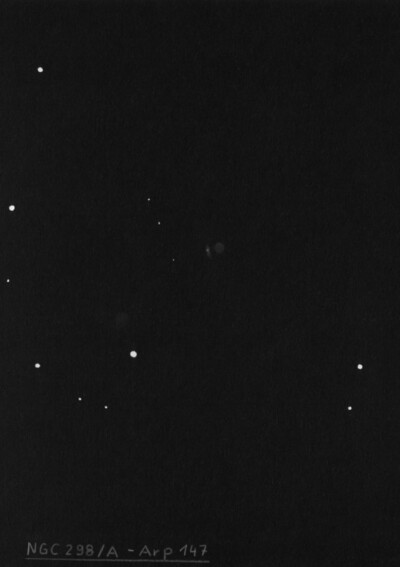
Stephane Javelle discovered IC 298 = J. 2-580 on 29 Dec 1893 and recorded "Small, nearly round, 1 'in diameter. It looks like the nebula covers two very small bright spots." Based on his description, it appears Javelle saw both components described in my observation. MCG appears to misidentify IC 298 as MCG +00-09-015 instead of MCG +00-09-014. Although IC 298 applies to both systems, PGC identifies the ring as IC 298 and the eastern component as IC 298A, while NED identifies the ring as IC 298A and the eastern system as IC 298B.
400/500mm - 18" (1/26/09): at 285x appeared very faint and small, elongated 2:1 ~N-S, ~18"x9", low even surface brightness. Located 3' NW of mag 9.3 SAO 111034. This is a remarkable pair of disrupted galaxies (Arp 147) forming a "10" or "IC" on images. The fainter western component (collisional Ring), forming the "C" or "0" was not visible.
900/1200mm - 48" (10/23/11): at 488x both components of this ring system were easily resolved. The eastern "collider" component (identified as IC 298A in PGC but IC 298B in NED) appeared moderately bright, fairly small, elongated 5:2 N-S, 24"x9", very small brighter core. The ring component (no nucleus) just west is a faint, small, irregularly round glow, ~20" diameter with a low but very uneven surface brightness. The rim was slightly brighter, creating a weak annular appearance, particularly on the east side. The system is located 3' NW of a mag 9.3 star.
Notes by Steve Gottlieb
IC 30
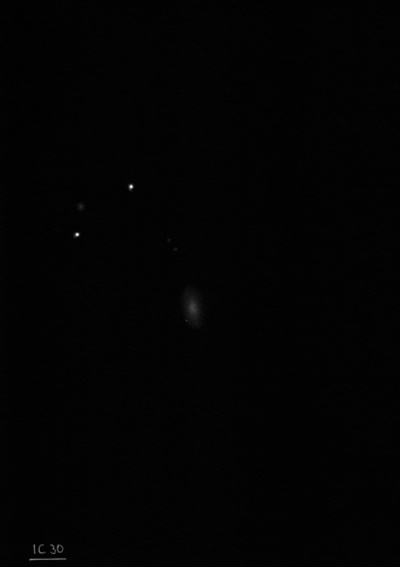
With a redshift z between 0.79 and .082 (depending on the source), this galaxy has a light-travel time of just over 1 billion years.
Stephane Javelle discovered IC 30 = J. 1-22, along with IC 29, 32 and 33, on 6 Nov 1891. His position is accurate. This is one of the 5 most distant galaxies discovered visually in the NGC/IC.
600/800mm - 24" (9/23/17): at 375x; extremely faint and small, 12" (probably the core only). The galaxy was only occasionally visible though confirmed. Second and probably faintest in a quartet of IC galaxies with IC 29 5.7' SSW.
Notes by Steve Gottlieb
HCG 16
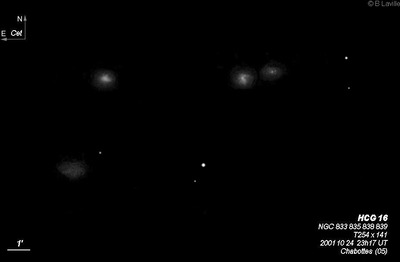
| Type | GALCL [S3] |
| RA | 02:09:33.3 |
| Dec | -10:09:47.0 |
| major_axis | 8.3' |
| mag | 10.2 |
| surface_bright | 99.9 |
HCG 7
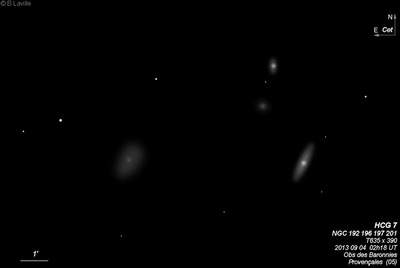
| Type | GALCL [E2] |
| RA | 00:39:23.9 |
| Dec | +00:52:41.0 |
| major_axis | 7.4' |
| mag | 11.4 |
| surface_bright | 99.9 |
HCG 15
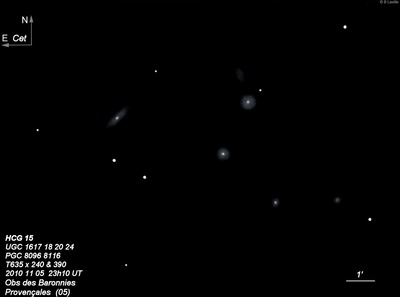
| Type | GALCL [E3] |
| RA | 02:07:39.0 |
| Dec | +02:08:18.0 |
| major_axis | 10.0' |
| mag | 11.7 |
| surface_bright | 99.9 |
HCG 25
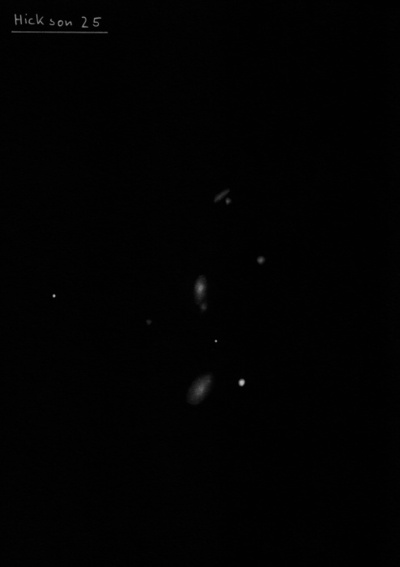
| Type | GALCL [S3] |
| RA | 03:20:43.7 |
| Dec | -01:03:07.0 |
| major_axis | 8.3' |
| mag | 11.8 |
| surface_bright | 99.9 |
HCG 11
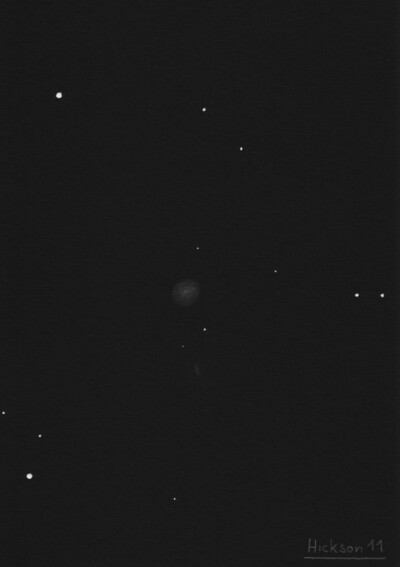
| Type | GALCL [S1] |
| RA | 01:26:34.3 |
| Dec | -23:13:52.0 |
| major_axis | 6.4' |
| mag | 12.1 |
| surface_bright | 99.9 |
HCG 14
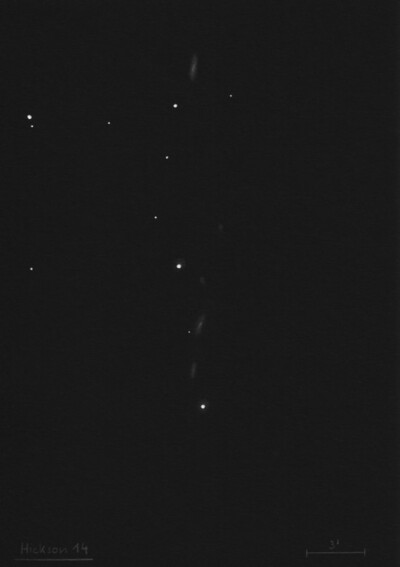
| Type | GALCL [S3] |
| RA | 01:59:47.6 |
| Dec | -07:01:43.0 |
| major_axis | 8.69' |
| mag | 12.1 |
| surface_bright | 99.9 |
HCG 19
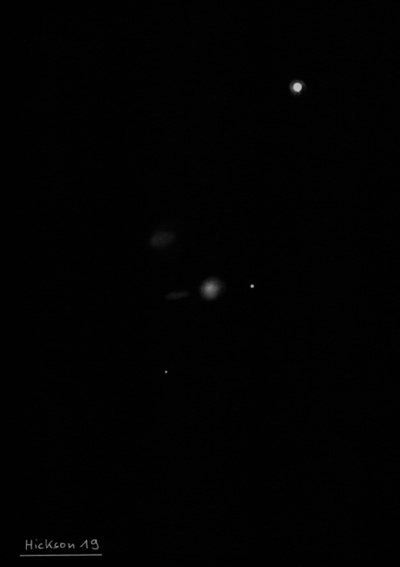
| Type | GALCL [E3] |
| RA | 02:42:45.1 |
| Dec | -12:24:43.0 |
| major_axis | 4.0' |
| mag | 12.1 |
| surface_bright | 99.9 |
HCG 3
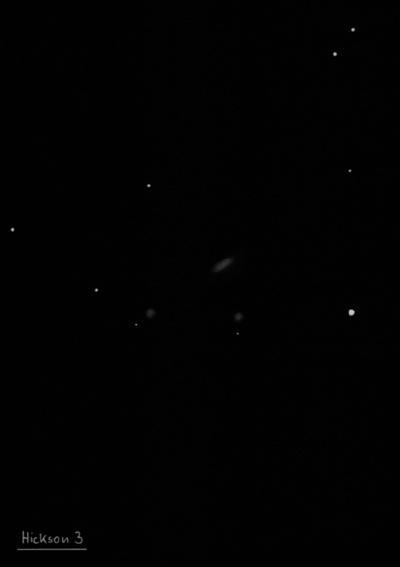
| Type | GALCL [S2] |
| RA | 00:34:11.5 |
| Dec | -07:35:35.0 |
| major_axis | 4.9' |
| mag | 12.3 |
| surface_bright | 99.9 |
HCG 6
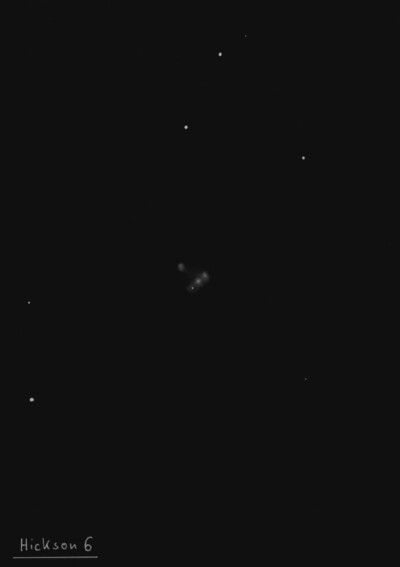
| Type | GALCL [E3] |
| RA | 00:39:10.1 |
| Dec | -08:23:43.0 |
| major_axis | 2.1' |
| mag | 12.3 |
| surface_bright | 99.9 |
HCG 4
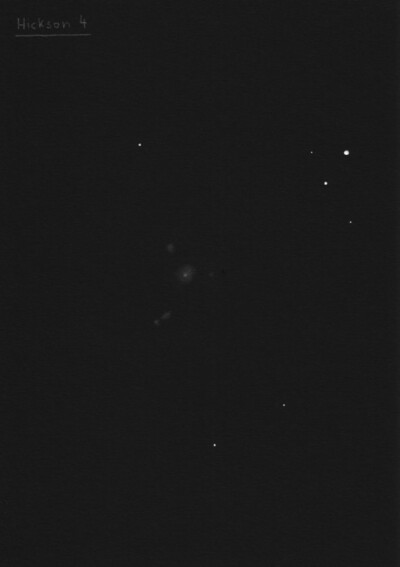
| Type | GALCL [S1] |
| RA | 00:34:16.0 |
| Dec | -21:26:48.0 |
| major_axis | 4.7' |
| mag | 12.5 |
| surface_bright | 99.9 |
HCG 12
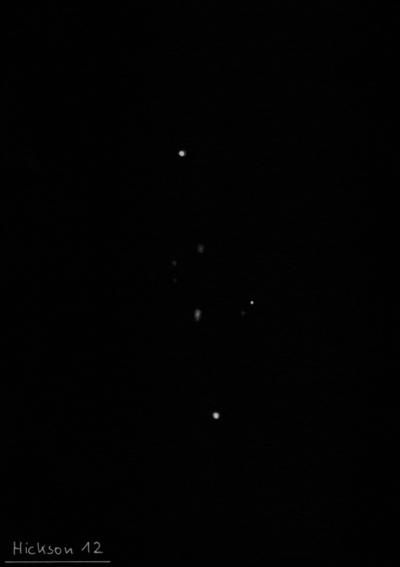
| Type | GALCL [E1] |
| RA | 01:27:33.7 |
| Dec | -04:40:14.0 |
| major_axis | 3.4' |
| mag | 12.9 |
| surface_bright | 99.9 |
HCG 9
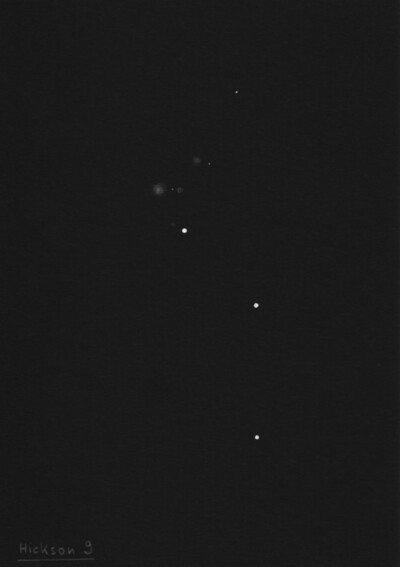
| Type | GALCL [E1] |
| RA | 00:54:18.0 |
| Dec | -23:33:04.0 |
| major_axis | 2.7' |
| mag | 13.1 |
| surface_bright | 99.9 |
HCG 13
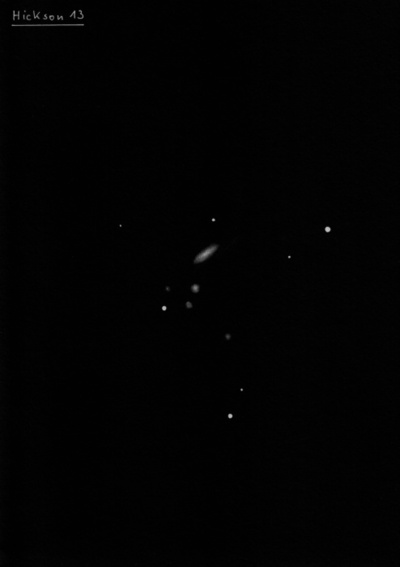
| Type | GALCL [E2] |
| RA | 01:32:22.1 |
| Dec | -07:52:52.0 |
| major_axis | 3.3' |
| mag | 13.3 |
| surface_bright | 99.9 |
PGC 6966
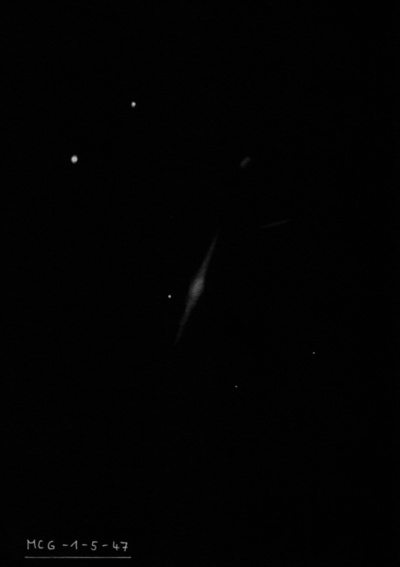
| Type | GX [Sc] |
| RA | 01:52:49.0 |
| Dec | -03:26:49.0 |
| major_axis | 3.2' |
| minor_axis | 24.0'' |
| position_angle | 163.0 |
| mag | 13.7 |
| surface_bright | 14.5 |
Abell 194
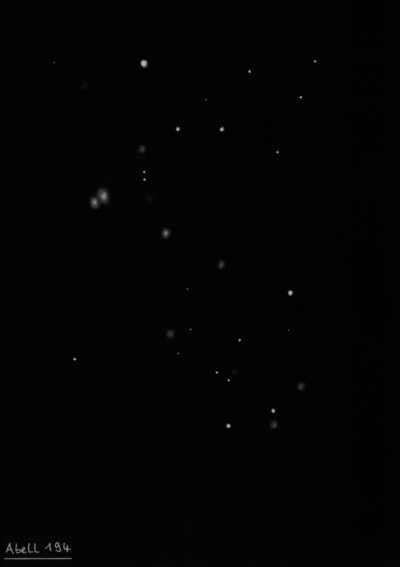
| Type | GALCL [01II] |
| RA | 01:25:30.0 |
| Dec | -01:30:00.0 |
| major_axis | 56.0' |
| mag | 13.9 |
Abell 400
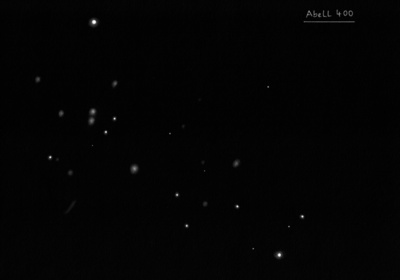
| Type | GALCL [1II-III] |
| RA | 02:57:36.0 |
| Dec | +06:02:00.0 |
| major_axis | 56.0' |
| mag | 13.9 |
